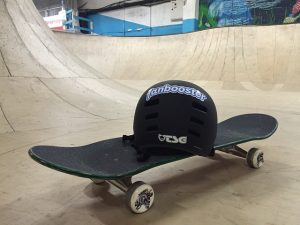When skateboarding, style matters. However, we believe that skateboard safety is equally important. That’s why we’ve created this buying guide for skateboard helmets. It will help you understand the importance of wearing a skateboard helmet, the features to look for, and how to choose the right skate helmet.

We’ll review the safest materials available today, and because we know looks matter, we have some stylish options for you too! We’ll also cover maintenance and replacement tips to keep your skateboard helmet in top shape.
Skateboarding is a popular sport, but it is essential to remember that it requires protective gear, such as skateboard helmets (certified helmets), knee pads, elbow pads, and wrist guards, for the protection of your head and body from possible injuries. You can always check specific sizing chart for more accurate sizes. Moreover, you can also buy online and add to your cart, and take advantage of their free shipping policy and return policy for your convenience.
This article explores essential protective gear and tools for skateboarding, focusing on three key components that enhance safety:
- Skateboard Helmets: The skateboard helmet is crucial for protecting your head from impacts and abrasions while you skate. It should fit securely and be constructed from durable materials like polycarbonate and ABS plastic to withstand multiple impacts. You can always check their sizing chart for more accurate sizes.
- Skateboarder’s Knee Pads: Knee pads are vital for shielding your knees from scrapes and bruises during skate sessions. These pads should provide ample cushioning and support to ensure safety while you skate.
- Skateboarder’s Elbow Pads, Gloves & Wrist Guards: These pieces of gear are important for protecting your arms during falls. Both elbow pads and wrist guards should have a snug fit and be made from breathable fabric to maintain comfort and protection while skating.
By understanding and utilizing these protective gear accessories, skateboarders can enhance their safety and enjoy a more secure riding experience.
Remember, a great skateboarder isn’t just about tricks and speed; they are about smart choices, too – starting with their skateboard helmet!
So, let’s dive in and learn how to skate safely…in style!
Key Takeaways
At FamilyHype, we prioritize product safety and style when it comes to skateboarding. That’s why we’ve discussed the essential attributes to consider when purchasing a skateboard helmet: features, fit, materials, and style.
We believe that the main focus of skateboard safety includes attributes such as skate helmet weight, ventilation, foam pads, helmet straps, sweatbands, comfort, durability, and visibility. Keeping this in mind, make sure to maintain and replace your skateboard helmet accordingly to ensure top-notch safety.
Style and safety go hand-in-hand when it comes to skateboarding, so consider the skateboard helmet options and skate apparel available and find the one that suits your needs, do not forget to consult the sizing chart for accurate sizes. With the right skateboard helmet, you can stay safe and stylish and enjoy every moment of your ride.
Have a great ride, and don’t forget to give your feedback to us at FamilyHype! We highly value your opinion and experience with this content.
Guide: Importance Of Skateboard Helmets
At FamilyHype, we understand the importance of skateboard helmets (certified helmets). Not only are they stylish, but they’re also life-saving pieces of gear that can’t be underestimated. Skateboarding injuries are unfortunately increasing, which is why skateboard helmet legislation is becoming more and more important.
As a community that values service and safety, we must prioritize the need for protective measures and advocate for them. To make an informed decision, it’s necessary to know the essential features of skateboard helmets (certified helmets) and consult a sizing chart for accurate measurements. Let’s explore those next.

From skateboarders to parents, it’s vital to recognize the importance of skateboard helmets (certified helmets) and the role they play in protecting our well-being on wheels. The key element for this article is safety, which includes skate helmet features, protective measures, and legislation as the three entities, each with its own attributes and values.
It’s our responsibility as a community to ensure the safety of skateboarders and make sure they have the proper gear to protect them.
Essential Helmet Features
When it comes to skateboarding, it’s essential to consider certain features when selecting a skate helmet. FamilyHype can help you find the perfect fit, unrivaled in maximum protection and comfort.
Let’s not overlook the importance of good ventilation, as it keeps your head cool during long rides. Adjustable straps also ensure a secure fit and enhanced safety.
When choosing a skateboard helmet, consider other factors such as the correct skate helmet size chart, shape, padding, material, and color. Each of these attributes will affect the comfort and performance of the skateboard helmet. Additionally, pay attention to the construction of the helmet, as this will influence its durability and achieve maximum safety. You can also buy online and take advantage of their free shipping policy and return policy for your convenience.
Ultimately, when skateboarding, you want a skateboard helmet that has a proper fit and provides optimal protection. By following the tips mentioned above, you can be sure to find the perfect helmet and consult their sizing chart to give you more accurate protection. This will keep you safe and comfortable.
We hope this article has provided you with the information you need to make an informed decision when buying a sale skate helmet in a shop for skateboarding. Be sure to share your account experience, return, and shipping feedback and opinions with us in the comments below. And don’t forget to check out FamilyHype for all your skateboarding needs!

Skateboard Helmets Guide
Choosing The Right Skateboard Helmet Fit
Choosing a good fit and the right fit isn’t just about comfort. It’s a crucial step in ensuring that your noggin stays protected during your thrilling rides. Here at FamilyHype, we understand the importance of finding the perfect helmet for your skateboard adventures.
- Measure Head Circumference: Start by measuring the circumference of your head or measure your head to find the right size for your skateboard helmet. Use a measuring tape and focus on the widest part of your head to ensure accuracy.
- Check Interior Padding: The interior padding of the helmet should be snug against your head. This snugness is essential to prevent the helmet from shifting while you skate.
- Adjust the Chin Strap: Make sure the helmet’s chin strap is adjustable and sits comfortably against your chin. Proper adjustment is key to prevent the helmet from wobbling during skate movements.
- Assess for Pressure Points: Ensure there are no pressure points within the helmet that could cause discomfort or headaches during use. A good skateboard helmet should feel comfortable throughout your ride.
- Material Safety: Understand the materials used in your skateboard helmet. The safest helmets are made from materials that can withstand impacts and protect your head during falls.
Now, let’s delve into the heart of skateboard helmet safety – understanding the safest materials used in production. When it comes to skateboarding, the right CPSC helmet protects your head and can make all the difference in terms of the Safety Commission and Consumer Product Safety Commission.
Make sure to pick certified skate helmets by the CPSC Safety Standard (Consumer Product Safety Commission), certified helmets by ASTM (American Society for Testing and Materials), and EN (European Norm) standards for skateboard helmet safety, certified sign policy and safety standards.
Additionally, look for CPSC certified helmets made with durable materials such as hard plastic and EPS foam, which offer the best protection and long-term use.
Safest Helmet Materials
Next, let’s delve into the heart of skateboard helmet safety and safety standards – the materials used in their construction. It’s crucial to grasp how these CPSC-certified skateboard helmets are built and to compare various materials utilized, as this directly impacts our safeguarding while out on the board. You can reach out to their customer service and ask about their return policy for your convenience.
As we navigate through this important topic together, you’ll gain a more comprehensive understanding of what makes a skateboard helmet truly safe and reliable.
Understanding Helmet Construction
Diving into the nitty-gritty of skateboard helmet construction, let’s get a better understanding of the intricate details behind helmet regulations and padding innovations to ensure optimal safety and safety standards.
Here at FamilyHype, it is our responsibility to ensure that our readers are fully equipped with the necessary knowledge and understanding of skateboard helmets. We’ll look at different skateboard helmet materials and their safety performance to get a better understanding of the main focus of cpsc certified helmets, which includes components such as shell material, lining, padding, and chin straps.
It’s important to note that skateboards and helmets are intimately connected, as skateboarders rely on skateboard helmets to protect them from potential injuries. Therefore, we want to make sure that you are fully aware of the safety features associated with helmets so that you can make an informed decision when it comes to purchasing one.
Now that we’ve got a grip on skateboard helmet construction basics let’s move on to compare different materials for their safety performance. We’ll look at factors such as strength, durability, and other safety features to get a better understanding of the best material for skateboard helmets.
Feel free to share your feedback and experience with us, as we’d love to hear your opinions on this topic.

Comparing Helmet Materials
Having unpacked the basics of skateboard helmet construction, let’s delve into the materials used that are important for safety. At FamilyHype, we know that a safe helmet doesn’t have to compromise on style.
The material’s durability and impact absorption qualities are crucial for safety. Some helmets use lightweight polystyrene, which effectively absorbs shock on impact. Others opt for hard-shell ABS plastic, known for its toughness.
Next, we’ll show you some fashionable or classic options that don’t skimp on protection. As skateboarders, we know the importance of choosing the right helmet, as it’s the most important piece of safety equipment.
When considering helmets, you should look for a mix of quality materials, including polycarbonate, polystyrene, ABS plastic, and EPS foam. These materials each have their own unique properties that make them ideal for skateboard helmets. Polycarbonate is known for its strength and flexibility, while polystyrene and ABS plastic are both lightweight and tough. EPS foam is the most common material used in skateboard helmets, as it provides superior shock absorption and impact energy resistance.
We hope this article has helped you understand the different types of helmet materials available and how they can help keep you safe when skateboarding. Please share your feedback and experience with us!
Skateboard Helmet Options
After thoroughly understanding the importance of safety and learning about the safest materials used in skateboard helmets, let’s now shift our focus to style.
We’re all aware that staying safe doesn’t mean you have to compromise on looking good. So, we’ll delve into the latest trends, taking the skateboard helmet design world by storm and introducing you to some top brands known for their stylish yet protective gear.
Latest Trends In Skateboard Helmet Design
Introducing the latest trends in skateboard helmet design, blending safety and style seamlessly for an unforgettable ride. FamilyHype writers and editors are proud to explore the best skateboard helmet designs that are sure to protect you while looking great.
From customization to innovative design features to diverse aesthetics, the skateboard helmet industry is offering something for everyone. Let’s take a look at the top brands for stylish helmets that combine quality and sophistication.
Helmet customization is one of the biggest trends in skateboard helmet design, allowing pro riders or adult riders to personalize their gear to reflect their unique personality. Designing innovations are also becoming more commonplace, with advanced materials and ingenious features that keep skateboarders ahead of the game. Lastly, aesthetic variety is something that shouldn’t be overlooked, with a range of designs from sleek minimalism to vibrant graphics.
We hope this article has inspired you to explore the latest trends in skateboard helmet design. Share your feedback, experience, and opinions in the comments below. Don’t forget to check out FamilyHype for more great skateboard content!
Top Skateboard Helmet Brands
Are you looking for the perfect headgear that seamlessly combines style, function, and safety? If so, you’ll want to check out the top brands for stylish skateboard helmets.
Here at FamilyHype, we’ve researched the best helmet brands out there that’ll make you stand out from the crowd. Popular helmet brands such as Triple Eight and Pro-Tec have earned a stellar reputation for their high-quality, fashionable designs. Whether you’re looking for a one liners, classic, sporty, or customizable skateboard helmet, these brands have got you covered.
In addition to finding the perfect helmet, it’s also important to know how to keep your headgear in top condition. Properly maintaining your skateboard helmet will help ensure its longevity and peak performance.
Skateboard Helmets: Maintenance & Replacement
While we’ve explored the most stylish helmet options, let’s talk about how to maintain and replace them properly.
We understand that your skateboard helmet is more than just a safety gear; it’s an extension of your personality. Therefore, it’s essential to keep it clean and stored correctly, but equally vital to know when it’s time for a replacement to ensure your ongoing safety.
How To Clean And Store Your Skateboard Helmet
Cleaning and storing your helmet is not only important to its longevity, but it’s also essential for safety. FamilyHype recommends keeping your helmet in a cool, dry place away from direct sunlight and water.
Properly sanitizing and storing your helmet can help maintain its structural integrity and keep it bacteria-free. Signs that your helmet needs to be replaced include cracks, dents, or fading of the material.
It’s also important to regularly clean your skateboard helmet with a mild soap and warm water solution to keep it in top condition.
At FamilyHype, we understand how important skateboard safety is to the family unit. That’s why we suggest following the steps above to keep your helmet in good condition. If you have any questions or feedback about this article, please share your thoughts with us. We’d love to hear from you!
When it comes to skateboards, helmets are a must-have safety item. To ensure your safety while skateboarding, it’s essential to clean and store your helmet correctly. Following the guidelines above can help protect your skateboard helmet and keep it in good condition for longer. Make sure to take the necessary precautions to stay safe while skateboarding and keep your helmet in top condition.
When To Replace Your Helmet
It’s time to take a look at your helmet and assess if it’s time for a replacement. Worn-out, damaged, or impacted helmets should be retired and replaced with an upgraded model that offers improved protection.
At FamilyHype, our goal is to ensure your safety while skating, and we understand that parting ways with an old helmet can be tough. Skateboard safety is a combination of the right protective gear, such as helmets, elbow pads, knee pads, and wrist guards, as well as the proper skill set.
Skateboard Helmets: Conclusion
At FamilyHype, we prioritize safety and style when it comes to skateboarding. Here are the main points to consider when choosing and using skateboard helmets:
- Importance of Skateboard Helmets: Every skate session should begin with putting on a helmet. It’s not just a safety measure; it’s a necessity for protecting against head injuries.
- Choosing the Right Helmet: Select a helmet that fits properly and meets safety standards. This is crucial for ensuring effective protection while riding your skateboard.
- Maintaining Your Helmet: Regular maintenance of your skateboard helmet is key. Clean it regularly and inspect it for signs of wear and damage to ensure it can continue to offer optimal protection.
- When to Replace Your Helmet: Replace your helmet at the first sign of significant wear or after a major impact, even if no damage is visible. Regular updates to your skate gear are essential for maintaining safety standards.
- Stylish Options: Today’s skateboard helmets are not only safer but also more stylish. You can choose from a variety of designs with Consumer Product Safety Commission standard and reflects your personal style while ensuring safety.
Have a great ride, and don’t forget to share your feedback with us at FamilyHype!
Frequently Asked Questions (FAQs):
How Do I Choose A Skateboard Helmet?
- Find a helmet that fits well for skateboarding. The helmet must fit you correctly; therefore, it is important to look about until you locate one that does. A too-large helmet provides less protection. Uncomfortable to wear and unlikely to be used at all, a helmet that is too tiny. Ensure that the straps and adjustments are simple to use and situated correctly for you.
How Do I Know My Skateboard Helmet Size?
- When purchasing a new helmet, bring your kid or teen along so you can make sure the fit is the right size. Wrap a soft tape measure around your child’s or teen’s head, just above their eyebrows and ears, to determine the head size. From front to back of your head, make sure the tape measure remains level. Helmet sizes frequently differ from brand to brand. Therefore, it’s important to measure your head against a ruler if you don’t have a soft tape measure. It’s crucial to examine the fit and dimensions of the helmet brand formulas to determine the appropriate helmet size for your child or teen in height. You may refer to a sizing chart for starters. You may refer to the brand’s sizing chart once you measure your head size of the person using a measuring tape.
Is It Okay To Wear A Helmet While Skateboarding?
- Professionals advise that helmet use is essential, particularly while vert and bowl skating. Accidents can occur at any time; you never know when they’ll happen. You can prevent head injuries like concussions and skull fractures by taking proactive measures to protect yourself. Helmets are crucial for supplemental safety.
Do You Need A Specific Helmet For Skateboarding?
- Use of a skateboarding helmet or skate helmet is advised. Skateboarding can be done while wearing a bike helmet, but it is not advised. Bicycle helmets or bike helmets are made to protect against high-speed collisions, but they cannot offer the same level of protection against frequent low-speed impacts and falls as skateboard helmets.
How Do I Know If My Skate Helmet Is Too Small?
- A snug helmet is necessary unless it is so tight that it causes an uncomfortable headache. Your helmet should protect your head; therefore, if it is painfully tight around your head and temples, you should probably take another measurement of your head or measure your head while looking for a new helmet.
Is It Better To Size Up Or Down In Helmets?
- Select the more compact size. Adjust straps, remove fit cushions, or twist the dial fit mechanism as needed to customize the consumer product. A bicycle helmet should fit snugly but not too tightly. It shouldn’t tilt back and should rest flat on your head. In the case of a crash, an unfastened helmet has a significantly higher chance of coming off. However, you shouldn’t wear a helmet that is too tight and uncomfortable in any other location, such as the jaw or chin, or that gives you a headache.
Do Skate Helmets Expire?
- No, but they should be replaced every now and then. The helmet should be replaced after extended periods, specifically after five years of continuous use. It’s crucial to remember that the helmet should continue to fit and provide adequate protection as youngsters grow. Even if there are no evident symptoms of damage following a violent hit, all skate or cycle helmets should be replaced. Even though it cannot be seen with the human eye, the helmet may very well be split internally. Sweat can also damage the foam that makes up the inner shell, which is what gives the shell its shock-absorbing qualities. You should get a new helmet if the foam breaks or exhibits any signs of wear.
What Are The Most Common Injuries In Skateboarding?
- Traumatic brain injuries and fractures are the most frequent injuries sustained when skating. The forehead, forearm, ankle, elbow, wrist, head, and skull are the areas with the most often reported fractures. In cases when there is an open wound or break in the skin close to the site of the broken bone, an open fracture, also known as a complex fracture, may be more common in skateboarders than in non-skaters.
Are Half Helmets As Safe As Full Helmets?
- Many new riders struggle with the dilemma of whether to wear a full-face helmet or a half-helmet with an open face. Even though a half helmet provides much less protection than an open-face or full-coverage helmet, going helmetless is unquestionably safer. A three-quarter style helmet, also known as an open-face helmet or a full-face helmet, includes coverage in the frontal and temporal areas that a half-helmet lacks.
How Many Hits Can A Helmet Take?
- For instance, an EPS helmet is only effective in one crash on your board. If the blows aren’t too severe, an EPP helmet can take several hits. Even if you have never crashed while wearing a helmet, avoid using it for longer than five seasons. The only unchanging rule regarding helmets is that if you crash while wearing one, replace it regardless of wear. Helmets for cyclists are one-time-use safety equipment and for consumer product safety. Compressing the foam inside the helmet’s plastic shell renders it incapable of providing you any protection.
Last Updated on July 5, 2024 by Nisa Jabajab
DISCLAIMER (IMPORTANT): This information (including all text, images, audio, or other formats on FamilyHype.com) is not intended to be a substitute for informed professional advice, diagnosis, endorsement or treatment. You should not take any action or avoid taking action without consulting a qualified professional. Always seek the advice of your physician or other qualified health provider with any questions about medical conditions. Do not disregard professional medical advice or delay seeking advice or treatment because of something you have read here a FamilyHype.com.